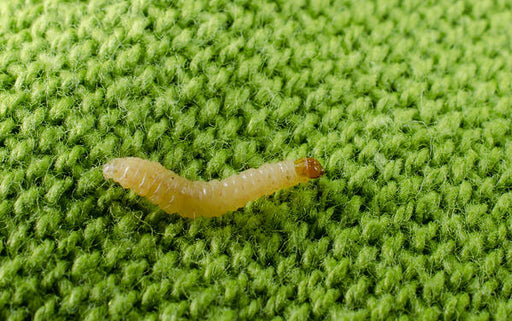How to Get Rid of Clothes Moths and Their Larvae - The Facts

.Clothes Moth Larvae emerge from the eggs of the Common Webbing Clothes Moth (the most widespread and prolific variety) and similar varieties that cause damage to clothes, carpets and home textiles.
It is clothes moth larvae that do the damage to clothes and textiles in the home, and specifically those made of natural animal based fibers. Wool, cashmere, silk, soft leather and fur are the main materials at risk.
We have answered the most frequently asked questions by customers about how to get rid of clothes moths and clothes moth larvae in this article. Hopefully you will have more information on how to get rid of clothes moth larvae after reading this!
How To Get Rid Of Clothes Moths And Clothes Moth Larvae - Steps:
- Identify the Clothes Moth - hang a clothes moth trap and catch active male clothes moths
- Assess the intensity of your clothes moth infestation - monitor the quantity of moths being caught
- Check your clothing for moth holes and moth larvae - inspect your natural fiber clothing closely (wool, cashmere, silk etc.)
- Clean your clothes - use the correct method of cleaning for each clothing type, include "freezing" in the wash cycle if necessary
- Eliminate moth eggs & larvae - clean closets, drawers, and wardrobes where clothes moths, their eggs and larvae can live - vacuum extensively
- Reduce the breeding of clothes moths in your home - keep pheromone clothes moth traps hung and replace when pheromones have lost potency
With those steps in mind, let's get into some more detail about how to eliminate flying clothes moths, their eggs and their wool-munching larvae from your expensive clothing collection!
Step 1: Identify the Clothes Moth
How Big Are Clothes Moth Larvae?
Clothes Moth Larvae are small and can be difficult to spot, especially if they are really tiny, having recently hatched from the microscopic eggs, enmeshed in garments with a loose weave, have made their way to the inside surfaces of garments, or have eaten their way deeply into the fabric (if left undisturbed for a long time).
When grown and prior to pupation, clothes moth larvae are between ¼ and ½ inch long. As you can see from the picture, they have a creamy color body and a darker brown head. You will see the relative size of the grown larva compared to the weave of the knitwear in this picture for an idea of relative scale.
Tips for Inspecting Clothing for Clothes Moth Larvae:
- When looking for clothes moth larvae in clothing, be really vigilant and look closely - there may be a range of sizes depending on how old they are since hatching and the temperature / humidity of their environment.
Step 2: Assess the intensity of your clothes moth infestation
How Long Do Clothes Moth Larvae Live?
Clothes moth larvae length of life before pupation and transforming into adult clothes moths varies depending on the conditions they encounter after they hatch from their eggs. Ideal conditions are relative warmth of around 70 degrees Fahrenheit and humidity between 75 and 80%. In such conditions, they can transform from egg to adult moth in a little less than a month.
If conditions are cooler and / or less humid, growth slows down - moth larvae can stay at the larval (and most destructive!) stage for two years or more if left undisturbed and sited with the right food source (i.e. your favorite soft knitwear or most precious rugs and carpets).
So, the answer to ‘how long do clothes moth larvae live?’ is anywhere between one and 24 months dependent on conditions.
Normally conditions depend on the season - less incidence of adult clothes moths flying in cold winter months and slower larval development.
Tips for Clothes Storage:
- Be vigilant all year round - the destructive larvae will be eating your clothes in centrally heated rooms in mid-winter even if you cannot see any clothes moths since the temperature dropped outside
- Please read our fall clothes changeover, spring wardrobe changeover, and clothes storage articles for guidance on protecting your garments, and act on the instructions and tips there
Step 3: Check your clothing for moth holes and moth larvae
Why Do Clothes Moth Larvae Eat Natural Fibers?
Once hatched from the egg Clothes Moth Larvae need energy to grow and pupate in order to turn into adult clothes moths. Adult clothes moths (those you may see flying around your house in search of your precious cashmere!) cannot eat - they live a very short lifespan purely with the intent of reproducing.
Wool, cashmere and silk are animal based fibers - keratin is the protein in animal fibers that provides nutrition for clothes moth larvae to eat. Keratin is also in human hair and skin which is commonly a large part of dust around the house and is equally attractive to clothes moths.
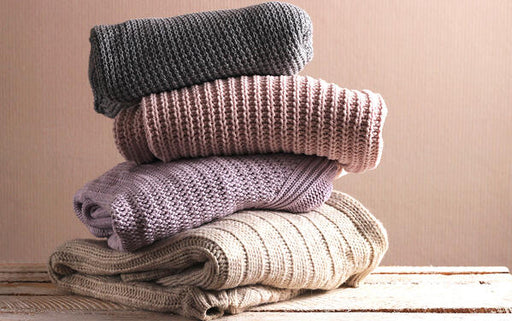
The perfect environment for a clothes moth infestation would be a dark, dusty, undisturbed, closet with animal-based natural fibre clothing. Often closets in spare bedrooms and attics are prime clothes moth breeding locations.
Also critical to clothes moth larvae is moisture, even very low amounts. Perspiration on recently worn garments that are placed back in closets, human scent, drinks spilled on clothing etc are all further attractions to the female clothes moth in deciding where to lay her eggs for the subsequent larvae to hatch.
Tips to Keep Clothes Moths Away From Natural Fibers:
- Only put clean clothing back in your closet
- Put recently worn garments on a hanger and air for 24-48 hours outside the closet before putting them away
Step 4: Clean your clothes
Does Washing Clothes Kill Clothes Moth Larvae?
Washing your clothes can kill clothes moth larvae, but it is unlikely to be a suitable solution for the types of garments that will be targeted as a food source.
The wash cycle needs to be at the hottest wash setting to kill moth larvae and eggs; more typically used for white cottons. But cotton does not contain the all important keratin. Woolens and silk clothes, which do, cannot be washed at those temperatures without damage.
Find out more on washing cashmere sweaters.
The main alternative is dry cleaning which will kill moth larvae and eggs - but obviously at a cost, and you may want to let your dry cleaner know that your garments potentially contain moth eggs & larvae.
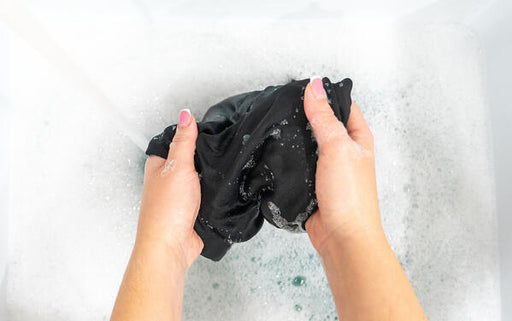
Tips for Ridding Closet Items of Clothing Moth Larvae:
- Examine clothing really closely - remember that cloth moth larvae are very small and often buried into the fibers of your clothing
- Dry clean precious and expensive garments
- Alternatively, deep freezing is a better option if you are looking to save money in dealing with larvae (see below)
- Be thorough - leaving clothes moth larvae in any garment risks a repeat infestation
Will Steaming Clothes Kill Clothes Eating Moth Larvae?
Steaming can help but is not a certain treatment to kill clothes moth larvae - it depends on the thoroughness of the treatment, duration of exposure to the steam and depth of the steam reaching into the garment’s fibers without risking damage to your precious garments.
So, it really depends - steaming clothes can help a little as part of a wider treatment regime but is not guaranteed to kill moth larvae.
Tips for Cleaning Area of Clothing Moths:
- Consider freezing and / or dry clean as more effective treatments
- Remember to thoroughly clean and vacuum your closets while your clothes are out and the closet is clear -- otherwise you, again, risk a repeat infestation
Will Freezing Kill Clothes Moth Larvae And Eggs?
Freezing will kill clothes moth larvae and eggs if carried out correctly. It is the most cost effective method for initially dealing with a clothes moth infestation but remember that the larvae and eggs will remain in the clothing even if they have been killed and you may want to follow up with cleaning of those particular garments to remove them.
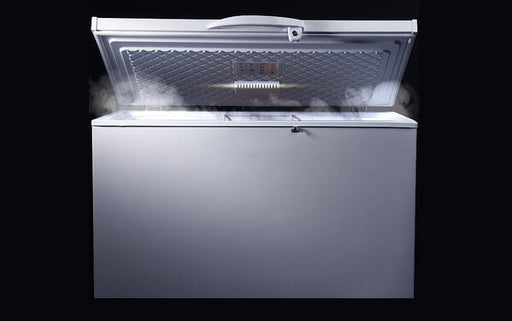
The recommended steps for freezing your clothes to kill moth larvae and eggs are:
- Identify and isolate the infested clothing items
- Place in a sealed, airtight bag, and do not over-stuff the bag with clothing to ensure all clothes properly freeze
- Deep freeze, ideally for a week, but at least 72 hours
- Thaw out and remove the garments from the plastic bag(s) outside your home
- Shake the garments vigorously
- Clean your garments according to their individual care labels - natural fibers will most likely require dry cleaning or hand washing, although some may be able to be washed on a delicate cycle in your washing machine
Tips for Freezing Clothes Moth Larvae and Eggs:
- It is critical that the bags you use are air-tight when placed in the freezer
- Please stick to the timings suggested above or you may face disappointment!
Does Sunlight Kill Moth Larvae?
Exposing clothes moth larvae to the sun will not in itself kill clothes moth larvae and you will find more effective methods to kill moth larvae above - especially freezing and dry cleaning.
It would require very hot conditions and very low humidity, combined with a long period in these conditions to have any assured effect - and that is likely to risk faded colors for your precious garments!
Your time is also precious and probably better spent on cleaning out your closets and using other methods to deal with the infestation rather than exposing your clothing to the sun in an attempt to kill clothing moths larvae.
Step 5: Eliminate moth eggs & larvae
What Kills Clothes Moth Larvae?
As we have outlined in this article, to answer the question ‘what kills moth larvae?’, deep freezing and dry cleaning are absolutely the best methods to kill clothing moth larvae. To continue monitoring for moths we recommend using Moth Traps which will also help break the breeding cycle by catching the active adult male moths.
For a more serious infestation you may like to read our Clothes Moth Kit Guide for information on how to use chemical products in line with our Traps to rid your home of Clothes Moths.
Can Clothes Moth Larvae Eat Through Plastic?
Absolutely not!
Plastic is neither attractive to, nor digestible by, clothes moth larvae, and their mouthparts will not be able to eat through plastic.
The softest (and sadly, usually, the most expensive items of clothing in your closet) are at the highest risk - they are the most digestible for the larvae.
Can You Vacuum Clothes Moth Larvae?
Yes! Your vacuum cleaner is your friend when it comes to dealing with a clothes moth larvae infestation.
When you have removed your clothes from the closet to follow our clothes care advice on dealing with clothes moths, you will need to vacuum and clean / dust thoroughly - moth eggs and larvae may be present, having either fallen off garments, infesting any natural carpets on the floors of built-in closets, or in the case of case-bearing moths, have attached themselves to the structure of the closet while pupating.
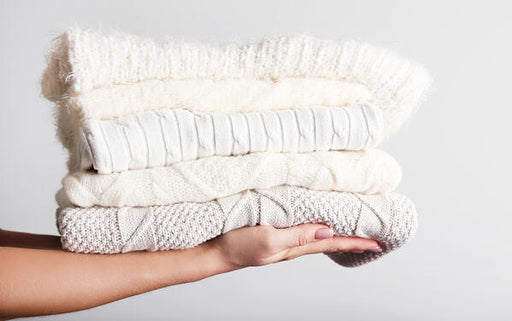
So, that means using your vacuum cleaner with the appropriate attachments to get to every corner, crack and crevice in your closet, as well as the flat surfaces and floor.
Then wash down and disinfect those same surfaces and, if necessary, use a residual pesticide spray. This is something we discuss further in our Clothes Moth Kit Guide.
After vacuuming, please empty your vacuum cleaner outside the home, into a bag, tie securely and dispose of in the trash - the last thing you need after that work is to then transfer eggs and / or larvae to another area in the home.
Does Fumigation Kill Clothes Moth Larvae? Do Bug Bombs Kill Cloth Moth Larvae?
Fumigation by using ‘moth foggers’ can help to deal with a serious clothes moth infestation. However, it is only likely to deal with adult clothes moths in the room being fumigated.
Clothes moth eggs and larvae are usually found in clothing where the effectiveness of fumigation will be limited - closely packed clothing will reduce the effectiveness of the fogger in terms of getting to eggs & larvae. Using the full recommended steps to clothes moth control will be needed, in addition to using professional treatments such as fumigation.
Does Ironing Kill Moth Larvae?
Ironing can kill moth larvae although it can be a ‘hit or miss’ affair - most delicate knitwear will need lower ironing temperatures, clothes moth larvae can be present deep in thicker ‘chunky’ knitwear and it would require comprehensive coverage of your garments to have any chance of being sure to be effective.
Dry cleaning and freezing for extended periods are more likely to give you reassurance of success in killing clothes moth larvae than ironing.
Step 6: Reduce the breeding of clothes moths in your home
Get Rid Of Clothes Moths And Clothes Moth Larvae Right
We hope this article has answered your questions about clothes moth larvae.
It may feel like a lot of work to deal with them thoroughly, and some expense if you use the right treatments and cleaning solutions, but it will save your clothes and a lot of money in damage to them. You could ask a professional pest controller to apply a treatment although many customers do not want someone working in their bedrooms and closets or the significant cost.
Please note that dealing with, and preventing the return of, clothes moths requires ongoing monitoring and routines to help you stop moths eating your clothes longer term. See our 10 Steps for Clothes Moth Control article for more guidance.
Ongoing prevention of clothes moths should involve the use of Pheromone Clothes Moth Traps like the one's that we've specially designed for preventing clothes moths infestations from occurring and getting out of hand.
FAQs
What Keeps Moths Out Of Wardrobes?
Moths are not attracted to the wardrobe, but to the delicious food source within it - your clothing - which will keep their larvae happily fed until it is time to pupate. Your woolens, silks, and any animal based fibers are at risk. Since they are always seeking out food for their offspring, the best way to keep moths out of wardrobes is to make the environment as unfavorable as possible.
To deter Moths from laying their eggs on the garments in your wardrobe you can take the following steps:
- Store clothing in garment bags or airtight containers,
- Ensure clothing is clean before storage
- Consider the use of natural moth repellents inside the wardrobe
- Use Clothes Moth Traps which use powerful female pheromones to attract the adult male moths.
How Do I Make My Closet Moth-Free?
Moths prefer dark areas that go undisturbed for long periods of time, such as the back of your closet. Keeping your closet moth-free requires a few steps and countermeasures, including airing out your clothing regularly, dusting and vacuuming up debris, using Pheromone Clothes Moth Traps, and utilizing natural repellents around the room.
Moths don't like lavender, cloves, and cedar, so place some herbal sachets in amongst your clothing.
How To Get Rid Of Moths In The Closet?
Getting rid of moths in a closet can be difficult if you don’t know what to look for. The first step is to identify the kinds of moths infesting your closet. Once you know what you’re dealing with, you can purchase the correct Pheromone Clothes Moth Traps. Start vacuuming and wiping everything down with white vinegar or a cleaning solution to help kill off moths, larvae and eggs.
Thoroughly infested, badly damaged items may need to be thrown away. Clothing with mild damage can be salvaged. You can take these items to the dry cleaners or freeze them at 17 degrees F/-8 degrees C for several days.
Is There A Way To Get Rid Of Clothes Moths Without Mothballs?
Yes, there are plenty of ways to eliminate Clothes Moths in the wardrobe or cupboard without mothballs, from Clothes Moth Traps which catch the adult males and help break the breeding cycle, to Moth Foggers and Moth Killer Sprays. Our Clothes Moth Kit Guide provides you with information about these products to tackle a moth infestation. Bear in mind that Natural repellents, such as lavender and cedar, will only act as a deterrent against Clothes Moths but will not kill them.
Otherwise, routine cleaning, laundering your items before putting them in storage, using airtight containers, and essentially cutting off their food supply will eventually get rid of all the moths in your home.
What Natural Repellents Work Best For Keeping Moths Out Of Wardrobes?
If you are wary about using strong pesticides, chemicals, or mothballs around your home, don’t worry. There are a plethora of natural, non-toxic repellents and deterrents that will keep moths out of your wardrobe and cupboards. This includes scents like lavender, cloves, and cedar chips. These repellents lack potency and long term effectiveness in contrast with pheromone moth traps.
Pheromone Clothes Moth Traps are also a non-toxic solution for keeping moths away from your precious clothing by attracting and catching moths. A word of note, do not place natural deterrents near moth traps because it interferes with the pheromones making them less effective.
Does Cleaning And Vacuuming Keep Moths Out Of The Wardrobe?
Yes, cleaning and vacuuming are crucial to keeping moths out of your wardrobe and getting rid of them for good. Cleaning with a disinfectant or white vinegar will kill moths, eggs and larvae. Vacuuming picks up any eggs and larvae, as well as frass, from damaged rugs and anywhere the moth larvae may be hiding. In short, vacuum and clean often.
How Do House Moths Get Into The Wardrobe Or Cupboard?
House moths can enter the home in a number of ways. If you purchased clothing from a secondhand store, moth eggs may be laying in wait to hatch. The best way to prevent moths from getting inside is to be proactive. For example, if you bought secondhand clothing, air outside in the sun or cold for a few days and then wash or dry clean immediately.
In clothes storage areas, keep humidity low. Moths are attracted to humidity and any moisture that gets into clothing.
About MothPrevention
MothPrevention® speak to customers every day about their clothes moth issues - clothes moths are a species that are ever increasing and that can cause significant damage to clothes, carpets and other home textiles.
To date, we’ve helped over 250,000 customers deal with their moth problems. We have developed professional grade solutions including proprietary pheromones and trap design, not available from anybody else in the USA.
